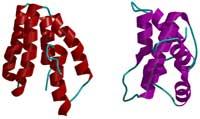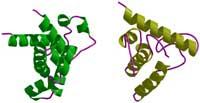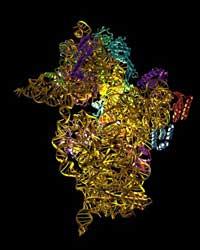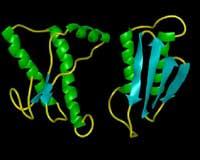Double before starting to work!
2002/09/25 Roa Zubia, Guillermo - Elhuyar Zientzia

Although formed in a chain, proteins must be folded into a three-dimensional structure to function. Somehow, these structures perform their work surrounding a small molecule and embracing them. But for this purpose the protein does not fold in any way, because only one of the thousand ways it can adopt. And, as the cell synthesizes, the protein is folding itself and always (or almost always) adapts to that only effective position.
However, when scientists do so in a laboratory, they do not achieve that result. Synthetic proteins, despite having the same chemical composition as one produced in nature, do not acquire their appearance; they are denatured in the folding process. Biochemicals are very concerned about this problem. How do proteins double in nature? Given the composition of a certain protein, is it possible to know the final structure? The scientist who manages to answer these questions will probably be a candidate for the Nobel Prize.
Research Research Research

The research lines addressed with this objective are, logically, numerous. But most of the sessions have made no progress. The tests have been done both in the laboratory and in the computer. For example, a group tried to study spontaneous folding, extending a natural protein and letting it bend by itself. But it is very difficult to understand general behaviors of this type of sessions.
Now, a team has achieved something with another method. In a computer simulation they have managed to predict how a small protein composed of 20 amino acids is folded. This is a difficult job, since the protein is folded by complex 'principles', which the team of researcher Carlos Simmerling has achieved at least once. The protein used, Trp-cage, is 20 amino acids and most of the human body has hundreds of amino acids, but it is the starting point. They are equally on the right path. Now we will have to see if this methodology adapts to any protein of 20 amino acids or only works in this case. However, one must speak of success and leave open a door to hope.

Gai honi buruzko eduki gehiago
Elhuyarrek garatutako teknologia






